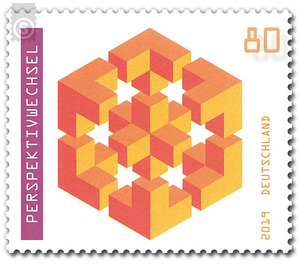Series "Optical illusion" - Change of perspective - Germany / Federal Republic of Germany 2019 - 80 Euro Cent
| Country | Germany / Federal Republic of Germany |
| Issue Date | 2019 |
| Face Value | 80.00 |
| Color | orange |
| Printing Type | Multicolor offset printing |
| Stamp Type | Commemorative |
| Item Type | Stamp |
| SID | 553014 |
| Dimensions | 39.00 x 33.00 |
| In 46 Wishlists | |
The postage stamp "Change of perspective" shows an impossible figure. Optical illusions of this category are graphically two-dimensional objects that are interpreted by the visual system as three-dimensional objects. As with the illustrated cube construction, the viewer recognizes a geometrically correct figure at first glance. Looking at it for a long time, however, leads to the insight that this cube cannot physically exist. The fascinating thing about this kind of optical illusion is that the original impression of a three-dimensional object remains even after recognizing the physical impossibility. The false first impression of a correct geometric figure arises from the laws of perception: objects and scenes are not captured by a single fixed point, but by several rapid eye movements. At first glance, the cube seems normal. But because it cannot be grasped in its entirety immediately, one looks at it in stages and it becomes apparent that something is wrong. Here it is the wrong perspectives that prevent a coherent image of a cube from being created. Impossible figures are only possible in the two-dimensional world of images. The Swedish graphic artist Oscar Reutersvärd is regarded as the first to introduce them to art. He is sometimes referred to as the "father of the impossible figure", although there are much older examples from the middle of the 18th century. Reutersvärd, however, was responsible for one of the best-known impossible figures, the Penrose Triangle (also known as the "Tribar"), and he was a forerunner of the Dutch painter M. C. Escher, who created numerous impossible figures. While Escher built inhabited worlds around impossible objects, Reutersvärd's impossible figures consist mainly of purely geometric constructs.


